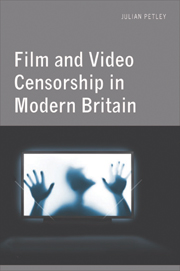Book contents
- Frontmatter
- Contents
- Acknowledgements
- Dedication
- Introduction
- Part I Censorious Rigmarole and Legalistic Overkill
- Part II After the Deluge
- Part III Nineties Nightmares
- 7 ‘Not Suitable for Home Viewing’
- 8 Vicious Drivel and Lazy Sluts
- 9 Doing Harm
- 10 The Anatomy of a Newspaper Campaign: Crash
- 11 The Last Battle, or Why Makin' Whoopee! Matters
- Part IV New Millennium, New Beginning?
- Appendix: The DPP List of ‘Video Nasties’
- Bibliography
- Index
7 - ‘Not Suitable for Home Viewing’
from Part III - Nineties Nightmares
Published online by Cambridge University Press: 05 August 2013
- Frontmatter
- Contents
- Acknowledgements
- Dedication
- Introduction
- Part I Censorious Rigmarole and Legalistic Overkill
- Part II After the Deluge
- Part III Nineties Nightmares
- 7 ‘Not Suitable for Home Viewing’
- 8 Vicious Drivel and Lazy Sluts
- 9 Doing Harm
- 10 The Anatomy of a Newspaper Campaign: Crash
- 11 The Last Battle, or Why Makin' Whoopee! Matters
- Part IV New Millennium, New Beginning?
- Appendix: The DPP List of ‘Video Nasties’
- Bibliography
- Index
Summary
By the early 1990s the ‘video nasty’ hysteria had subsided considerably from the levels it had reached during the first half of the previous decade, but a dreadful event on 12 February 1993 unleashed the deluge once again: this was the murder in Kirkby, Merseyside, of the two-year-old James Bulger by the ten-year-olds Robert Thompson and Jon Venables, who were convicted of the crime on 24 November 1993. The lurid, sensational and above all hate-filled reporting of the case by most British national newspapers marks the nadir of a journalistic culture infamous for its debased and degraded standards (for critical accounts of press reporting of the case, see Franklin and Petley (1996) and Green (2008)), but what concerns us here is the manner in which the popular press concocted and then spread the entirely untrue story that the older children had murdered the younger one under the influence of violent videos. Just how this ridiculous farrago emerged remains too little understood to this day, but as it was to lead directly to the further tightening of the Video Recordings Act, it is important to establish exactly what happened.
‘EXPOSURE TO VIOLENT VIDEO FILMS’
The one factor that is now well known is that the judge in the case, the Honourable Mr Justice Morland, made the entirely unwarranted remark in his summing up that ‘it is not for me to pass judgement on their upbringing [sic] but I suspect that exposure to violent video films may be in part an explanation’. Here indeed is a media effect: eleven years of ‘video nasty’ stories had clearly done their work. However, one strongly suspects that there is an element of class dislike lurking in here too, as in so many cases of this kind.
- Type
- Chapter
- Information
- Film and Video Censorship in Modern Britain , pp. 87 - 101Publisher: Edinburgh University PressPrint publication year: 2011

